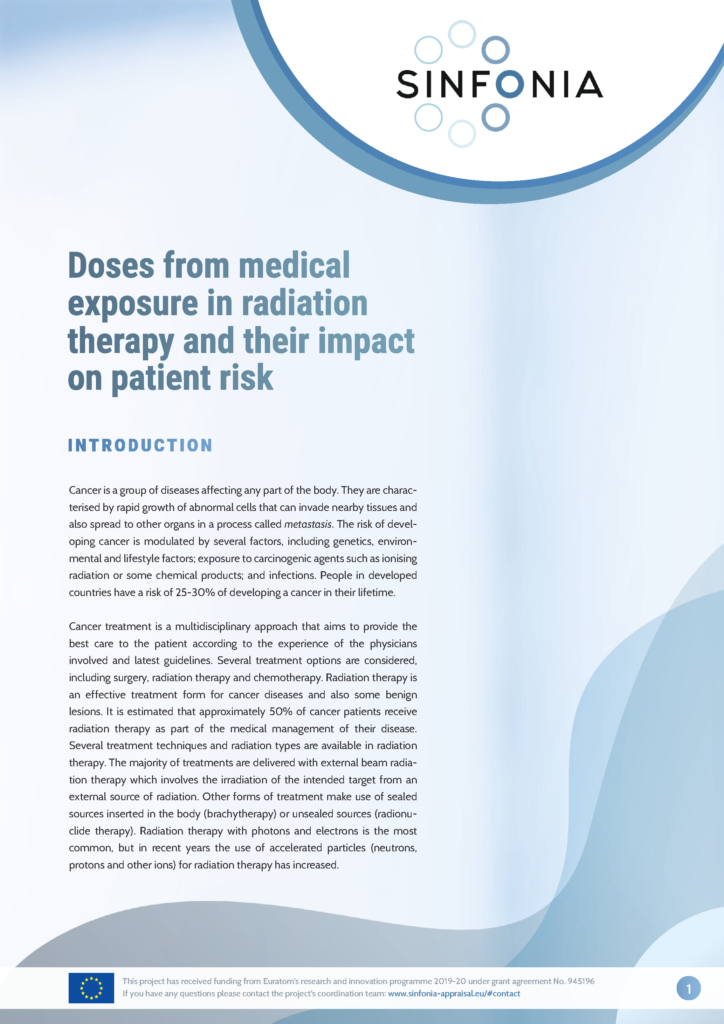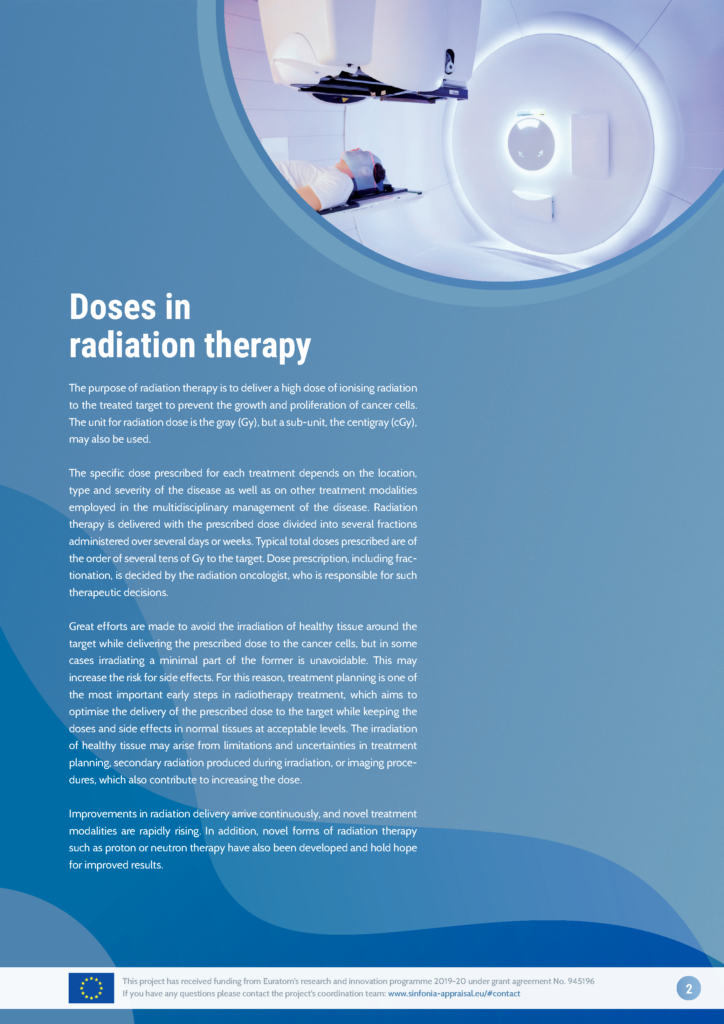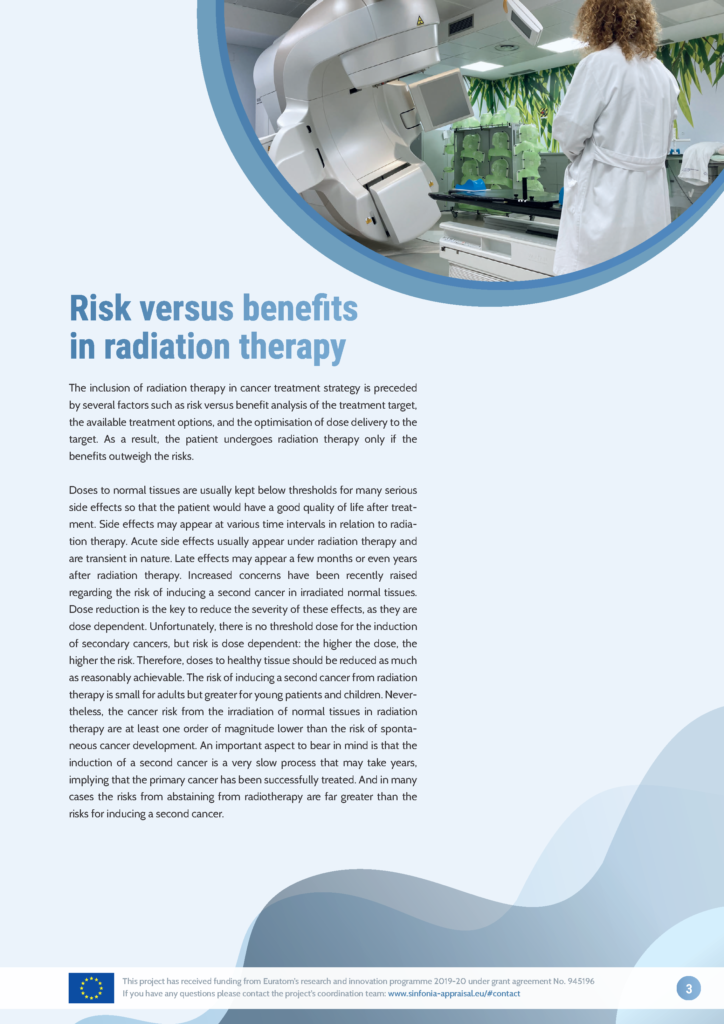


Q&A
Is radiation therapy an effective treatment modality?
Radiation therapy is a well-established form of treatment. It is employed in the cure or symptom control for a broad range of cancer diseases. While it can be used in combination with other treatment options, it represents the only treatment option for some patients.
How is the safety of radiation therapy ensured?
Highly specialised professionals are involved in treatment plan optimisation and delivery. Quality controls are regularly performed on equipment used for radiation therapy to ensure that the correct dose is delivered during procedures.
Does radiation therapy induce cancers?
Yes, but only rarely. It can be more harmful to refrain from radiation therapy even if there is a risk for cancer induction. Hereditary and lifestyle habits may have a higher contribution to the appearance of cancer than medical irradiations. The decision to administer radiation therapy is taken if the benefits outweigh the risks.
What are the risks from radiation therapy?
Irradiation of normal tissue may lead to the appearance of acute and late effects. Acute side effects appear typically under radiation therapy and are transient in nature. Late effects may appear a few months or even years after radiation therapy. Reducing doses to normal tissues can lower the risk for side effects.
Does radiation therapy make me radioactive?
Most radiation therapy does not make patients radioactive. Some procedures might induce minute amount of radioactivity, but they do not pose significant risks for the patient or other people around them. Other procedures specific to radionuclide therapy, a discipline of radiation therapy, involve the introduction of radioactive substances in the body in order to bind to and destroy tumour cells. Patients may still be radioactive a certain time after treatment while the substances are still inside the body. Nevertheless, they are discharged from the radiation therapy facility only when this is considered safe.
What are the benefits of radiation therapy versus its risks?
The inclusion of radiation therapy in the management strategy for cancer is the result of a risk versus benefit analysis of the intended treatment purpose, the available treatment options and the optimisation of dose delivery to the target. The decision to administer radiation therapy is taken if the advantages are higher than the risks. It is however important to note that radiation therapy represents the only treatment option for some patients.
Are there any differences between doses in radiation therapy and diagnostics?
Doses in radiation therapy are several orders of magnitude higher than in diagnostic procedures. Nevertheless, all use of ionising radiation for medical procedures is subjected to the same principle that the advantages of using it are higher than the risks.
Is fertility affected by radiation therapy?
Radiation therapy to the reproductive organs or to regions nearby such as the pelvis and abdomen may affect sperm count or eggs in the ovaries. Nevertheless, it is the amount of radiation dose absorbed by the reproductive organs that determines whether or to what degree fertility is affected.
Should a pregnant woman undergo radiation therapy?
Radiation therapy during pregnancy is advisable only after carefully weighing the benefits of the procedure and the risks of disease progression during pregnancy against the potential harm to the foetus. For radionuclide therapy there is an additional risk that the radioactive substances used can be passed to the foetus.
Does radiation therapy hurt?
Radiation therapy itself does not hurt. However, some of the acute and late effects may cause transitory or longer-lasting pain to the patient. Nevertheless, doses to normal tissues are usually kept below thresholds to minimise the pain and maintain a good quality of life for the patient.
Aside from the risk of a secondary cancer, what are the imminent side effects of radiation therapy?
Side effects may appear at various time intervals in relation to radiation therapy. Acute side effects like reddening of the skin usually may appear under radiation therapy or shortly afterwards and have a transient nature. Late effects like fibroses may appear a few months or even years after radiation therapy.
Glossary
Accelerated particles (neutrons, protons and other ions) – subatomic particles or atomic nuclei that may be accelerated and used in radiation therapy to stop or delay the growth of cancer cells.
Benign lesion – condition, tumour or growth that is not cancerous in nature.
Brachytherapy – treatment modality employing radiation sources placed inside the body of the patient.
Carcinogenic agents – physical or chemical agents that may cause cancer.
Chemotherapy – treatment modality employing drugs to stop or delay the growth of cancer cells.
Electrons – negatively charged subatomic particles that may be accelerated and used in radiation therapy to stop or delay the growth of cancer cells.
External beam radiation therapy – treatment modality employing a radiation source placed outside the body of the patient.
Photons – bundles of electromagnetic energy that can travel through matter. High energy photons may be used in radiation therapy to stop or delay the growth of cancer cells.
Radionuclide therapy – treatment modality employing radioactive substances injected in the body to stop or delay the growth of cancer cells.
Sealed sources – radioactive material enclosed or fixed in a protective capsule of solid material, usually metal or plastic.
Secondary radiation – radiation generated in and around the treated area due to interaction of radiation with the medium.
Treatment modality – therapeutic technique or approach used by health care personnel to treat or improve the condition of patients.
Unsealed sources – radioactive material, usually liquid or gas, not enclosed or fixed and which can move around.
Link to the Glossary of the International Commission for Radiation Protection (ICRP): ICRP Glossary – ICRPaedia